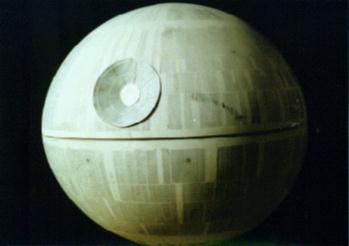
Posted on 06/13/2004 8:33:37 AM PDT by kennedy
NASA's Cassini space probe confirmed Saturday that it had completed a flyby of Saturn's largest moon, Phoebe, coming within 1,285 miles of the small, dark body.
The craft's main antenna was pointing away from Earth during the flyby Friday afternoon. Engineers at the National Aeronautics and Space Administration's Jet Propulsion Laboratory in Pasadena, Calif., did not receive word of the craft's successful pass until 10:52 a.m. EDT Saturday, when the craft re-oriented itself and began transmitting pictures and data back to mission control.
Most of the data and pictures will be released today, but the early unprocessed images show that Phoebe is a badly pitted rock festooned with craters and large gashes.
"This is an extremely battered, old surface we're looking at," science team member Torrance Johnson said. "There are deep craters from other debris that over eons have pockmarked the surface. It's roughly round, but it's really chipped away."
Saturday's images reveal that the small moon, only 137 miles in diameter, is heavily cratered, with multiple impacts giving many of the craters a jagged, irregular appearance. Many of the craters are smaller than 0.6 miles in diameter, indicating they were produced by the impact of bodies smaller than 100 yards in diameter.
Some of the craters have lighter-colored rays extending outward, suggesting that the moon has a light-colored interior covered with a coat of darker material. Whether objects that caused the craters were cometary or asteroidal in origin or were caused by the debris from other impacts within the Saturn system is hotly debated.
Cassini made a variety of spectroscopic measurements of the moon that should reveal much about its composition and, hence, its origin. That data, along with pictures that are expected to have 10 times the resolution of Saturday's, will be released today.
Friday's flyby was Cassini's only encounter with Phoebe. On June 30, the craft will fire its retrorockets and enter orbit around Saturn, where it will spend four years studying the planet and its inner moons.
Last I checked, Titan was Saturn's largest moon, followed by Rhea, Iapetus, Dione, and several others whose names I can't recall. Phoebe is one of the smallest Saturn moons that have been named (over a dozen have been identified since 2000 but not named).
Phoebe is a moon and it orbits Saturn, so I suppose they got more facts correct than usual.
I was thinking the same thing. Nice of news outlets to get facts straight before printing.
And obviously a dorky teenage moon as far as moon's go.
I think it Mark Twain who said that a reporter can do research and investigate, or simply repeat what was told to him -- but both approaches pay the same.
Yeah, I thought the headline meant that they'd gotten photos of Titan's surface.
This reporter probably has as much interest (and knowledge) in space issues as I do in Crochet.
"Photos of Saturn's largest moon show badly pitted surface"
It's Bush's fault!! ;)
What do you expect from an Austin paper - after all, they are only 'reporters' who barely know any American history or geography and are attempting to sound a bit educated.
Maybe if they took some night courses at TAMU they could learn something useful?
It's those damned SUVs. If only Algore had been elected President then we would have adopted the Kyoto accord and the Universe would be safe.
Phoebe is the largest OUTER moon.

Officials at NASA are considering a plan to remedy the condition by crashing a gigantic tube of Clearasil onto the moon's surface.
Looks to me like Cocoa Puffs.



ROFL

That's no moon. It's a space station!
Disclaimer: Opinions posted on Free Republic are those of the individual posters and do not necessarily represent the opinion of Free Republic or its management. All materials posted herein are protected by copyright law and the exemption for fair use of copyrighted works.